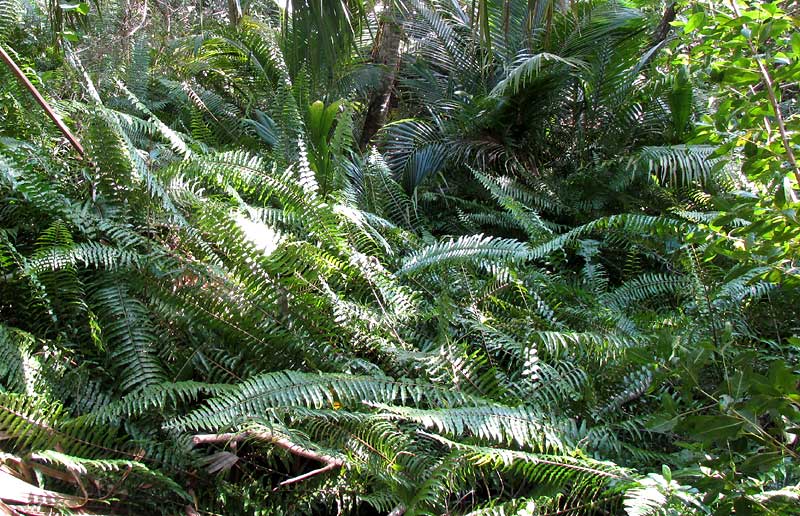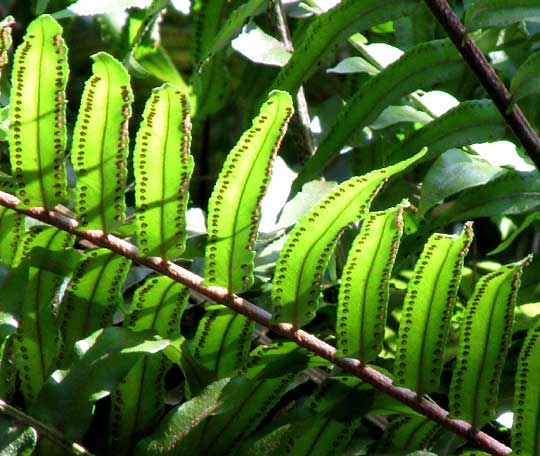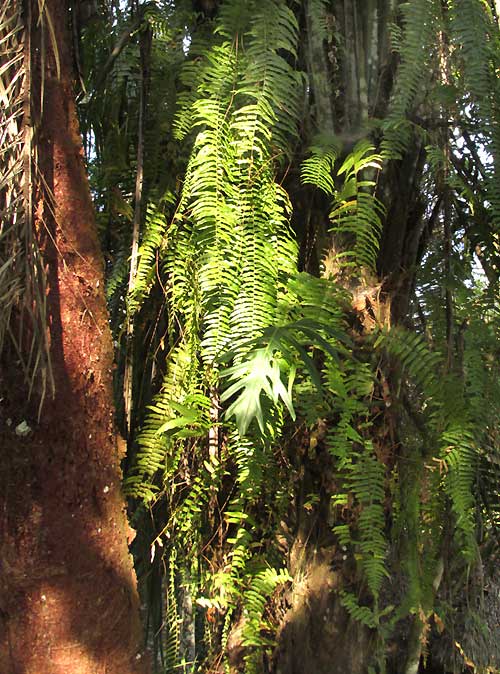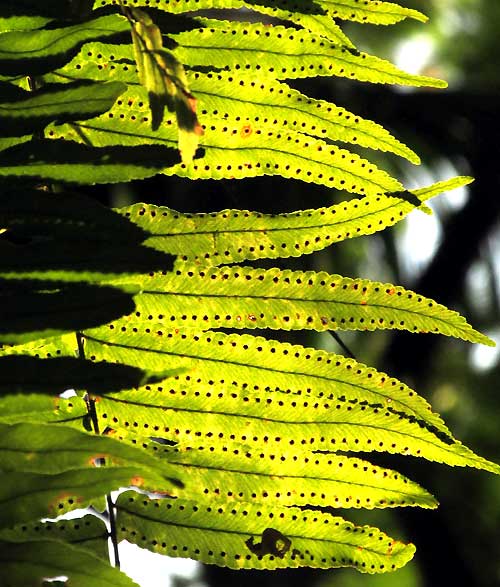Excerpts from Jim Conrad's
Naturalist Newsletter

from the February 1, 2015 Newsletter issued from Río Lagartos, on the Yucatan Peninsula's northern coast (~N21.60°, ~W88.16°), Yucatán state, MÉXICO
GIANT SWORD FERN
About a kilometer into the mangroves east of Río Lagartos, at Petén Tucha where we've seen Spider Monkeys swinging among branches of strangler fig trees, some years ago a tree fell, opening the canopy so that sunlight, at least at mid-day, floods onto the forest floor. The forest floor there is ankle-deep in brackish water. Nature's reaction to this penetration of sunlight into an otherwise shadowy and somber understory has been to engender the massive tangle of eight-ft-tall (2.5m) ferns, shown at the top of this page.
Those giant ferns glowing in sunlight during their brief mid-day photosynthetic rush put one in mind of the Carboniferous Period 300 million years ago, when giant dragonflies glided among treelike lycopods, seed ferns, horsetails and cordaites, whose dead bodies when sunk into swamp mire eventually lithified into the stuff we call coal. But the sunlight does something else, too: They backlight certain fronds so that their clusters of fruiting bodies, or sori, easily can be seen on pinna undersides, as shown below:

Seeing the sori is important because every fern has its own way of grouping its spore producing sporangia, so if you can see the sori, you've seen important field marks. In the last photo this big fern's sori look like round warts in single file just inside the pinnae's margins. Another good field mark is the fern's stiff main stem, or rachis, that almost looks woody, and is round in cross section.
This is the Giant Sword Fern, NEPHROLEPIS BISERRATA, occurring throughout the Earth's tropical and semitropical regions in a variety of habitats, not only in mangroves and woody swamps but also sometimes in clearings and roadsides, and even epiphytically on trees. In the US they occur in southern Florida.
At Petén Tucha the Giant Sword Fern is so rank and robust that you can't imagine taming it in a pot on your patio, but that's exactly what many gardeners do. Then the fern at best gets only half the size we see here, but it makes a handsome landscaping plant, and even looks good in baskets hung so that the fronds cascade over the sides.
Entry issued on May 26, 2019, with note from a March, 2019 camping trip into the Petén department of northern GUATEMALA
EPIPHYTIC GIANT SWORD FERN
Earlier this year in the campground of El Rosario National Park (elevation about 125m or 410 ft, ~N16.525°, ~W90.160°), on March 28th, many trunks of mature Cohune Palm, Attalea cohune, were heavily festooned with dangling ferns issuing from the axils of old, broken-off fronds, as shown below:

For identification purposes, the fronds were too high to look closely at the sori and other details, but with the camera's telephoto lens important details could be seen, shown below:

The closely packed sori situated closer to the pinnules' margins than to the midribs, the scalloped margins of the pinnules, the pinnules' tips gradually narrowing to long, slender tips, and the lack of apparent large hairs on the rachis are all typical of the Giant Sword Fern, Nephrolepis biserrata, we've seen in the Yucatan's coastal swamps. Nephrolepis species can be hard to distinguish from one another without more detailed analysis, but Nephrolepis biserrata is a species to be expected here, and that species is known to grow epiphytically on palm trunks, though most commonly is seen on the ground in wet habitats.
Giant Sword Fern occurs throughout the tropical and subtropical Americas, including southern Florida, as well as in Africa and southeastern Asia.